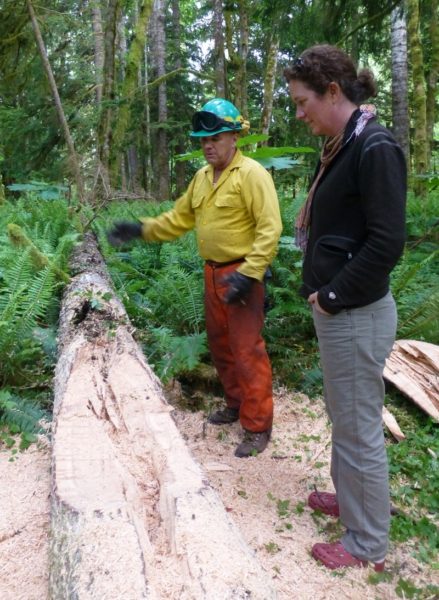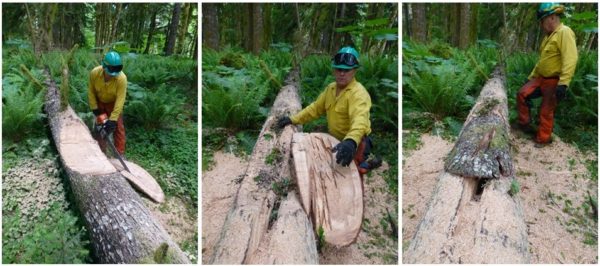
How to Help the Creepy Crawlies on the Forest Floor
by Tim Brown and Ken Bevis
The forest floor is rich with life, largely unseen, largely small. Salamanders and small mammals creep and crawl about in the great struggle for survival that is nature. While battling with red teeth and claws, they need quiet places to rest, reproduce, feed and regroup. All of this drama quietly unfolds beneath our very feet, and downed logs play an integral role.
These creatures live beneath and within the rich decayed material that is derived from our forests. Wood and leaves break down mostly through fungus, enhanced by the actions of insects, amphibians, reptiles and small mammals that chew wood, and move spores about. Dead trees that have fallen over and become down logs offer some of the richest habitats in this universe of decay.
Many amphibians and small mammals make use of cavities in down wood for important life history phases. For example, many salamanders breed and feed in decayed wood and use spaces in rotting logs for critical cover. Red-backed voles and deer mice use interstitial spaces in dead logs and snags for cover and places to look for food. Douglas squirrels cache cones in down logs and use cavities large enough for them to enter. Pine marten and snowshoe hares covet large cavities in, and cover under, down logs.

Tim Brown shows Tara Chestnut, a landowner, how he is turning a recently downed log into a home for wildlife. Photo: Ken Bevis/DNR.
Yet, the down log can be a solid eminence for many years, and these animals sometimes have to wait for time to open up the logs to allow their entrance. Breaks, cracks and holes created by physical damage, animals or the action of fungus can take a long time to appear, or might never exist at all, before the log crumbles away into soil.
Can we help?
Of course! Targeted management action can enhance this process and provide immediate habitat for these small, unheralded but essential organisms. The normal tools of forestry applied in the cause of habitat creation will suffice; in other words, a chainsaw and a thoughtful operator.
Tim Brown has been creating wildlife habitats out of trees for over 42 years. He got his start as a logger and firefighter, and progressed to become a nationally recognized leader in wildlife tree habitat techniques*. Tim recently spent a day with me in western Washington and we created a habitat log on a small forest landowner’s property near Mt. Rainier.
We located a recently toppled hemlock behind the home of Tara Chestnut, a local landowner, and with her permission we “worked it up” using Tim’s chainsaw and expertise. I asked Tim some questions as the work progressed.
What wildlife species will benefit from this work?
Lots. Including: salamanders, mollusks (snails and slugs), beetles and other arthropods, ants, spiders and many small mammals such as mice or voles.
What ecological process are you trying to imitate or encourage?
“I am trying to expedite the processes where the animals can get inside of the log to propagate, feed and hide.”
What species and type of log works the best?
“I look for logs that are still sound and not too soft. Any species is good, but in western Washington the best are, (in order), cedar, fir, hemlock and then any hardwoods like alder or cottonwood. Bigger is better, always.”
What about slope position or landscape location?
“Since many of these creatures we are targeting like moist places, the closer to the riparian areas the better.” Lying across, rather than down, a slope is preferred, as the uphill portion of the log will collect soil and moisture.”
How do you make a habitat log?
Tim used his saw to cut into the log at various angles and provide entrances and cavities within the log for the use of small wildlife. He used his saw like a knife, plunging into the log at various angles. He prefers a 24-inch or larger blade for this kind of carving work.
“I make a series of slits and slashes into the log to allow wildlife to access the inside of the log right away. I put some cuts down low so that creatures on the ground can access the interior of the log. Slits should be about three times the saw’s width to be large enough for these small critters to enter.”

Left: Tim Brown cuts a slab from a hemlock log. Center: Duff and vegetation are placed into chambers and slits carved into the log. Right: The finished product. Note the entrance on top. Similar slits on the lower edges allow for an alternate entrance.
Tim explained that the middle of the log was accessed by taking a big slab out of the top, about one-third of the way through, in an arc pattern. This works well, as it is a single cut, and then it sits back on top without having to fasten it on. Water will infiltrate and collect in the log along the cracks created by the cuts. Sometimes, people will nail the slab on. If you use steel nails make sure the log will never be cut up for wood; a heavy rock placed on top could do the trick.
After the slab is removed, slits and chambers are created in the center of the log. Chambers inside of the log are accessed by the slits that go all the way through, some out the bottom and side of the log. For small mammals, try to make the slits slightly wider by pushing the saw through three times or more.
Remove as much sawdust as possible so passages are not clogged.
For amphibians and mollusks, Tim adds soil and some organic material to give a jump-start to decay. He thinks small mammals prefer dry habitat, so try to keep the chambers clear for them; they will bring in nesting material.
“I often cut a suspended log so that it falls into contact with the ground. If it is hanging above ground, or there are branch stubs holding it up, decay won’t work as quickly. We want it to decay, and now we have instant habitat value from the entrances we created into the log.”
Tim has gone back and monitored logs like this one he has created over the years, and reports plentiful wildlife use of these created log habitats, including small rodents, marten and salamanders. He has even hollowed out larger logs to create bear dens. (Subject of a future article).
Down logs benefit many forest wildlife species, and provide opportunity for the small forest landowner to enhance habitats. Be creative. Use your saw to hollow out solid logs and help the little critters use them more, and sooner, in the decay process.
Let us know what you try, and send some pictures of your project!
There’s life in dead wood.
Contact us for more information or training on Tim’s wildlife tree techniques.
By Tim Brown, wildlife tree creation expert, 206-271-2020 and Ken Bevis, DNR stewardship wildlife biologist, Ken.Bevis@dnr.wa.gov, 360-489-4802
*(Material used with copyright permission from Timothy K. Brown)